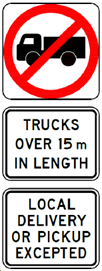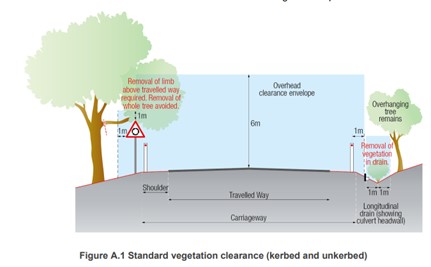The Australian Road Rules (Rule 104 "No Trucks Signs") states:
(2) A driver (except the driver of a bus) must not drive past a no trucks sign that has information on or with it indicating a length if the length of the driver's vehicle (or, if the driver is driving a combination, the length of the combination) is longer than that length, unless the driver is permitted to drive the vehicle on a route passing the sign under another law of this jurisdiction. Offence provision.
(4) This rule does not apply to a driver if the destination of the driver lies beyond a no trucks sign and—
(a) there is no other route by which the driver's vehicle could reach that destination; or
(b) any other route by which the driver's vehicle could reach that destination would require the vehicle to pass another no trucks sign
Note : defined in the Australia Road Rules dictionary.
"truck" truck means a motor vehicle with a GVM over 4.5 tonnes, except a bus, tram or tractor
"bus" bus means a motor vehicle built mainly to carry people that seats over 12 adults (including the driver). Note— Motor vehicle is defined in this dictionary,
"combination” means a group of vehicles consisting of a motor vehicle connected to 1 or more vehicles. Note— Motor vehicle is defined in this dictionary, and vehicle is defined in rule 15 of the Australian Road Rules
"driver's vehicle" for a driver, means the vehicle being driven by the driver.,
"GVM" means Gross Vehicle Mass. For a vehicle this means the maximum loaded mass of the vehicle— (a) specified by the manufacturer on an identification plate on the vehicle; or (b) if there is no specification by the manufacturer on an identification plate on the vehicle or if the specification is not appropriate because the vehicle has been modified—certified by a vehicle registration authority. Note— Vehicle is defined in rule 15 of the Australian Road Rules
"with" with, for information about the application of a traffic control device, includes accompanying or reasonably associated with the device.
Source: Australian Road Rules (legislation.sa.gov.au)
In summary, if truck drivers are going to a destination beyond the sign, that they cannot reach by any other route, they are allowed to pass the sign. Viz. Australian Road Rule 104(2) and (4).
The signs would legally restrict larger trucks from entering Hahndorf, but not if they had a destination there – e.g. no local impact to deliveries or consignment of goods, delivery of
building materials, etc.
Drivers with no business in the township would need to determine an alternate route.


